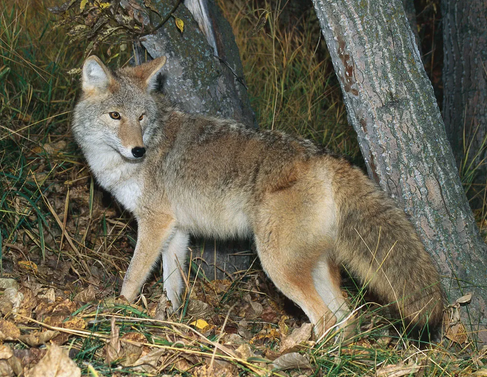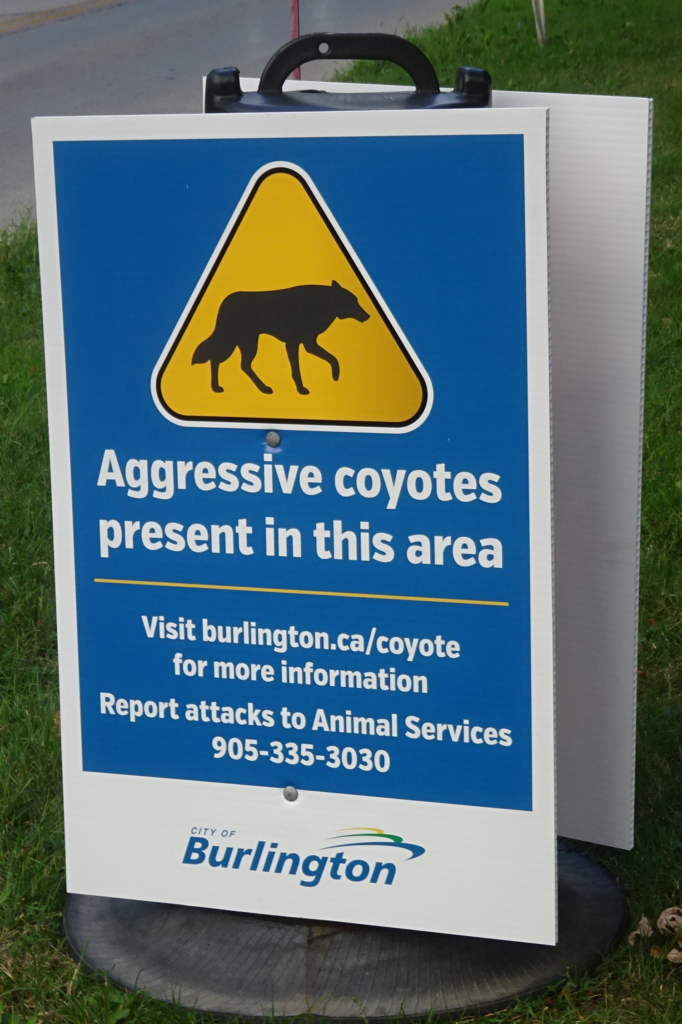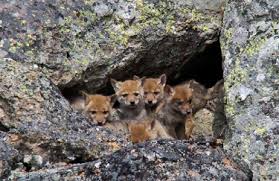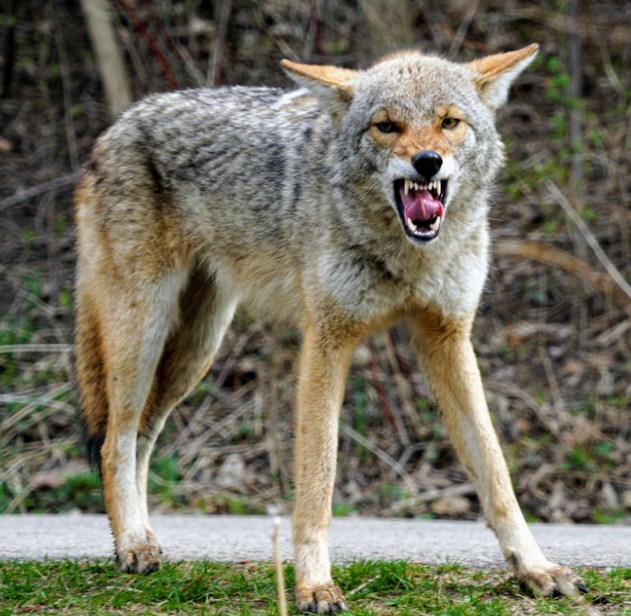 By Pepper Parr
By Pepper Parr
March 27th, 2023
BURLINGTON, ON
The strategy and plans to manage the coyote problem in Burlington will be in front of Council on Tuesday

A very attractive animal that tends to steer clear of people but will come very close and on occasion threaten people when it has not been able to find the food it needs.
While Coyote sightings are common in Burlington, the 7 unprovoked attacks of that took place in 2022 had people frightened and angry and wanting better management of the problem.
The Burlington & Oakville Coyote Management (BOCM) prepared a report and gave it to the city manager who, for reasons that were never clear, sat on it. Several Council members fumed over that. The city manager did eventually meet with the BOCM people; the city adopted a number of the recommendations, showing that citizens can make valuable contributions if staff would learn to listen to and take on ideas that make sense and compliment what Staff have done.
Dr. Dennis Murray, associate professor of biology at Trent University, said in a CBC program that “, the rapid rise in the coyote’s range and urban population is due to the intersection of many different ecological issues. Climate change plays a part. Coyotes do better when there’s less snow and so have been able to expand their range northwards. The absence of bigger predators like wolves has meant less competition for prey animals. And, Murray adds, the way we’ve built cities has changed to incorporate more parkland and green space, which is ideal coyote habitat.”

Police successfully tranquilized this bear and then caught it when it fell to the ground.
Wildlife control is a function of the Province with the Ministry of Natural Resources and Forestry overseeing the issue. They say “Wildlife such as coyotes, wolves, and other fur bearing mammals sometimes come into conflict with people. Municipalities are responsible for deciding on and taking appropriate actions when human-wildlife encounters create ongoing conflict situations on municipal property and can also take action on private property with the permission of the landowner.
The province supports municipalities by providing advice and expertise on actions they can take to resolve such situations.
However, when prevention fails, the Fish and Wildlife Conservation Act allows municipalities to protect their property by harassing, capturing or dispatching a variety of wildlife species, including coyotes, or to hire a licensed hunter or trapper to do so on their behalf. Municipalities may also take action to address human-wildlife conflicts on private property with the permission of the landowner. No approval or authorization is required from the province in these cases.
Municipalities may pay licensed hunters or trappers to hunt or trap fur bearing mammals within their municipal boundaries. The municipality determines the terms of any such arrangement, including the species of fur bearing mammals, the hunters or trappers involved, the number of animals, and the locations and time periods that apply.”
Burlington Animal Services recently completed the contract staff (2) hiring process for the CAAP (Coyote Action and Awareness Program) and the Animal Services team is now currently staffed with one supervisor, six animal control officers and four animal care and licensing attendants. Animal control officers are directly responsible for administering and enforcing applicable animal laws and regulations of the Province of Ontario and City by-laws pertaining to animals.
In the provision of the services, Burlington residents are assisted with stray animals, rabies mitigation, dangerous animal investigations, animal nuisances, loose livestock, injured animals and deceased animal pickup with these requests being related to domestic and/or wildlife.
While coyotes represent an increasingly difficult challenge, an increased demand has also been placed on Animal Services to deal with domestic animal issues; namely aggressive dogs in City-owned public parks and open space. Domestic animal bites alone account for almost 1 incident per week over the past 2 years 2021/2022.

Animal control officers are responsible for providing public education related to co- existing with coyotes including hazing techniques, assessing properties for known coyote attractants, investigations into encounters and attacks, investigating and issuing fines for illegally feeding coyotes and other wildlife, monitoring known coyote dens, and locating and eliminating coyotes involved in attacks on residents.
CAAP – Coyote Action and Awareness Program

The city installed signs in the parts of the city where coyote sighting were very high and where people had been bitten or nudged.
The seven physical coyote attacks on residents in 2022 during a 9-week period from July 30th to September 20th, 2022, Resulted in the activation of the Level II Crisis Management Team and followed the Coyote Response Strategy Escalation Protocol approved by Council. The Animal Services team focused their resources on locating and tracking the coyotes responsible and collaborated with a Certified Wildlife Professional (CWP) in their elimination.
A city manager’s office report estimated 2022 one-time cost of $22,850.
The Manager of Procurement Services was authorized to sign a multi-year agreement with the CWP for the remainder of 2022 and the duration of 2023, with the option to renew for three additional one year terms.
One of the results of the coyote experience was the consideration on the establishment of the proposed new Bylaw Compliance Department inclusive of an enhanced coyote response model as part of the Animal Services function.
That would mean the hiring of a new Director of Bylaw Compliance, to undertake a full review and update of the current City of Burlington Animal Services Bylaw (By-law 60-2005) and Coyote Response Strategy by Q4 2023.
Many of the recommendations of the community association – Burlington & Oakville Coyote Management (BOCM) were taken up and implemented by Staff.
The City Manager will be directed to initiate meetings, as required, with the Chief Administrative Officer of the Town of Oakville and senior staff of both Burlington and Oakville to develop and implement a coordinated work-plan related to both the BOCM recommendations as well as other City/Town coyote response initiatives including, but not limited to, joint procurement of external professional wildlife management services, joint coyote related data collection, research and analysis and public educational and awareness programs and possible mutual coyote response service agreements.
Roads, Parks and Forestry will be directed to procure and install lids for non-decorative garbage cans in the immediate area of coyote concern, to an upset limit of $15,000 in 2022; and
Building and Bylaw will be instructed to adopt a pro-active coyote response strategy model including adding two additional contract Bylaw Enforcement Officers, and engage appropriate coyote specialist resources to assist with investigations, canine response team, training staff and members of the public.
Direct the Mayor and Government Relations Manager to connect with the Ministry of Natural Resources and Forestry, and other ministries as needed, to formally request emergency funding, and staffing support, to help the City respond to coyote attacks in Burlington; and
The Executive Director of Legal Services and Corporation Counsel and the Director of Building and Bylaw reviewed the current fine structure for illegal dumping contained in the Lot Maintenance By-law and bring back options to increase the fines for ticketing offences, Part I and the maximum fine for Part III offences for the feeding of wildlife.
A city-wide mailing and social media communication plan was implemented that focused solely on the fact that the recent crisis of aggressive wildlife attacks is the direct result of illegal dumping and/or feeding of wildlife.
The Senior leadership, via implementation of the ECG (Emergency Control Group) identified immediate needs to have resources on hand and available for immediate deployment; Burlington has continued the procurement of a roster of CWPs (Certified Wildlife Professionals) trained and accredited to use lethal and non-lethal measures in Coyote control and mitigation tactics.
Interesting that the city hasn’t issued any reports on the size of the coyote population and where they have taken up residence. Do we know anything about the possible size of the pups born in the Spring ?

Trained and certified wild life experts knew how to find coyote dens.
City staff are able to assess potential den locations to either mitigate or remove the location prior to it becoming a public safety threat. To date a number of property audits have already been completed with highly positive feedback from the community.
Increased community visibility, signs and coyote education programs, via town halls, school pop-ups and proactive patrols are the continued focus of the CAAP team in 2023 and 2024 based on the two-year pilot time frame.
The education and enforcement regarding feeding of wildlife continues to be the foundational basis for the program, which also expands into proactive park patrols for domestic animals off-leash as well as the failure to remove domestic animal waste. This provides the community with multiple channels for relaying information to officers, either via email, telephone, or personal conversation with an officer patrolling a specific park or ward. This amplifies community engagement as well adds an additional layer of security by officers being readily available for any coyote-related issues which may arise.
A number of the 11 recommendations in the BOCM report were used by the city. There are joint meetings of Oakville and Burlington Animal Services staff where opportunities to work together to advance the recommendations provided by BOCM. Staff appreciate the efforts of BOCM and acknowledge that while all of the recommendations have been fully considered, not all of the recommendations have been supported.

When confronted by an angry coyote citizens were told to back away slowly – not to run and to report the sighting immediately.
The traumatic physical attacks have changed the dynamics of coyote-human co- existence within Burlington. While the City’s approved Coyote Strategy protocols addressed how unprovoked and provoked physical attacks would and in fact should be handled, those incidents have demonstrated the need for ongoing proactive response tactics, the implementation and endorsement of the CAAP program is achieving positive results.
Consideration is being given to the ability to track, tag and potentially collar urban coyotes. This program could potentially have revenue streams attached in the capacity of base donations or sponsorships of the animals being digitally monitored similar to the Yellowstone Wolf Program (State of Montana).
The costs incurred during 2022 were $88,190. These costs were not budgeted and therefore absorbed as part of the 2022 yea rend financial position
Total Financial Impact
The 2023 budget included a one-time funding in the amount of $580,488.00 for a two- year coyote response strategy. The two-year program includes two contract animal control officers, communication and literature costs as well as purchased services of CWPs and veterinary expenses.

Coyote pouncing on a spot where it has senses there is a small animal.
Coyotes have existed within the City of Burlington for decades and will continue to thrive in this current climate. Recent aggressive behaviour including the 2022 physical attacks on residents brought about the urgent need to enhance our response strategy and implement a rapid action team (CAAP) to deal with these urgent issues. Our ability to coexist with these animals is dependent on public understanding and controlled interactions which reduce the level of fear and increase the aversion conditioning tactics required to maintain that balance.
Council’s unequivocal support of the additional tactics and resources proposed will ensure that the Animal Services team is equipped to address escalated coyote situations in an expeditious manner.















My question has been and continues to be – What are the working hours of the animal control officers?
Do they all work from 8-4, or are they staggered so that an animal control officer is available later than 4PM.
Leaving a message on a machine after 4pm is a waste of time. Also should one call during the day do they simply leave a message or is there someone there to follow-up on a coyote citing?
I’ve yet to have anyone follow up, including when I reported a very sick looking coyote, conveniently spotted and reported during office hours. In my area, we’ve all given up reporting. We have learned it’s pointless.
A lot of words there. Over this weekend alone in Appleby Village I have experienced two sightings of two large coyotes roaming the streets. Good luck to all with small pets and children.